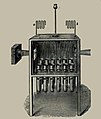
Size of this preview: 507 × 599 pixels. Other resolutions: 203 × 240 pixels | 551 × 651 pixels.
Original file (551 × 651 pixels, file size: 71 KB, MIME type: image/jpeg)
| This is a file from the Wikimedia Commons. Information from its description page there is shown below. Commons is a freely licensed media file repository. You can help. |

|
This file was moved to Wikimedia Commons from en.wikipedia using a bot script. All source information is still present. It requires review. Additionally, there may be errors in any or all of the information fields; information on this file should not be considered reliable and the file should not be used until it has been reviewed and any needed corrections have been made. Once the review has been completed, this template should be removed. For details about this file, see below. Check now! |
Summary
| DescriptionTyndalls setup for broths in optically pure air.jpg |
English: The above illustration originally appeared in year 1876 in "The optical deportment of the atmosphere in relation to the phenomena of putrefaction and infection" by John Tyndall in Philosophical Transactions of the Royal Society of London, Vol. 166, page 30. It depicts John Tyndall's mid-1870s scientific setup for the longterm preservation of fresh food broths inside a semi-sealed wooden box. Intentionally, outside air is allowed to enter the box, but there is blockage of micro-organisms from entering the box. The two wavy objects labelled a and b at the top of the box are glass pipes. They are filled with densely packed cottonwool. These pipes connect the outside air to the air inside the box. Floating micro-organisms and other air particulates in the outside air are blocked by the cottonwool from entering inside. Tyndall said in 1871: "The inability of air which had been filtered through cotton-wool to generate microscopic life had been demonstrated by [Heinrich] Schroeder [in the 1850s] and Pasteur." (Dust and Disease, 1871). For the box to be able to preserve fresh broths or other foods, the box cannot have micro-organisms inside it to begin with. For that objective, Tyndall came up with the idea of coating the inside walls and floor of the box with glycerin, which is a sticky syrup. After closing the box and waiting for a few days, he found the air inside the box becomes entirely particulate-free because the various floating-matter particulates all end up getting stuck to the walls or settling on the sticky floor. The glass vials at the bottom of the box are not coated with the glycerin. To sterilize the glass vials, Tyndall immersed them in boiling water from underneath the box, for half an hour, after the air had cleared. The two windows on the sides of the box are there to enable verification that the air inside the box does not contain floating micro-organisms or other particulates. Finally, newly boiled meat and vegetable broth is dropped into the glass vials via the long pipette at the top center of the box. At the spot where the pipette enters the box, the box material is rubber, and the rubber is pierced with just a pinhole to let the pipette enter. This system worked for Tyndall in 1875. But it failed in 1876. Tyndall traced the failure to bacterial endospores which are not killed by boiling. He then originated a way to destroy the endospores, called Tyndallization, which historically was the earliest known effective way to destroy endospores. |
| Date | |
| Source | The illustration is taken from John Tyndall's book Essays on the Floating-matter of the Air in relation to Putrefaction and Infection, first published in year 1881. The illustration has been taken from page 50 of the 1882 edition of the book at Archive.org. |
| Author | John Tyndall's commissioned drawer (anon) |
| Permission (Reusing this file) |
Public domain on account of its age |
Licensing
| Public domainPublic domainfalsefalse |
|
This work is in the public domain in its country of origin and other countries and areas where the copyright term is the author's life plus 100 years or fewer. | |
| This file has been identified as being free of known restrictions under copyright law, including all related and neighboring rights. | |
https://creativecommons.org/publicdomain/mark/1.0/PDMCreative Commons Public Domain Mark 1.0falsefalse
Original upload log
The original description page was here. All following user names refer to en.wikipedia.
| Date/Time | Dimensions | User | Comment |
|---|---|---|---|
| 2013-08-20 00:19 | 551×651× (72604 bytes) | Seanwal111111 | {{Information |Description=The illustration is taken from [[John Tyndall]]'s book ''Essays on the Floating-matter of the Air in relation to Putrefaction and Infection'', first published in year 1881. The illustration originally appeared in "The optical... |
Captions
Add a one-line explanation of what this file represents
Items portrayed in this file
depicts
1876
File history
Click on a date/time to view the file as it appeared at that time.
| Date/Time | Thumbnail | Dimensions | User | Comment | |
|---|---|---|---|---|---|
| current | 08:10, 2 April 2017 |  | 551 × 651 (71 KB) | Frankemann | Transferred from en.wikipedia |
File usage
The following page uses this file:
Global file usage
The following other wikis use this file:
- Usage on no.wikipedia.org